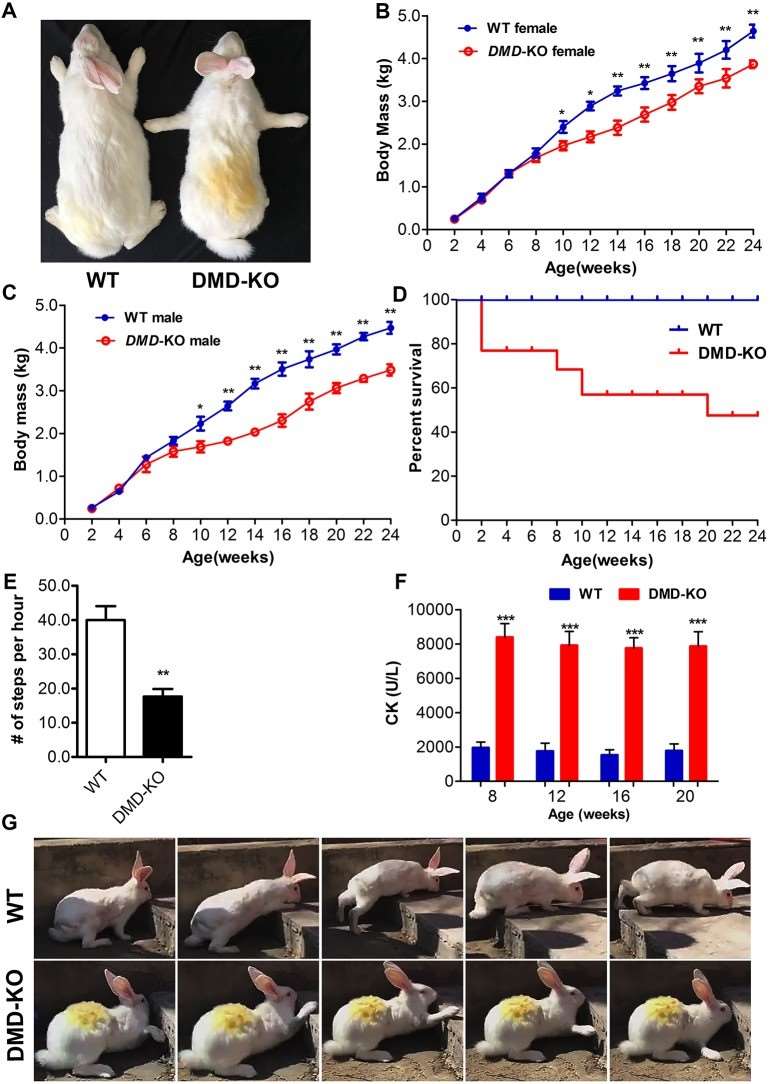
Our promise to you:
Guaranteed product quality, expert customer support.
 24x7 CUSTOMER SERVICE
24x7 CUSTOMER SERVICE
 CONTACT US TO ORDER
CONTACT US TO ORDER
CRISPR Rabbits for Muscular Dystrophy Research 
Duchenne muscular dystrophy (DMD) is a fatal X-linked recessive disease characterized by progressive muscle weakness and wasting. Many naturally occurring and gene-edited mammalian models have been established to study the pathophysiological mechanisms and develop treatments for various types of DMD, including mice, rats, dogs, and pigs. In terms of physiology, anatomy and genetics. Rabbits have more similarities to humans than mice, meaning that rabbit models more closely replicate the symptoms of human DMD and allow them to be developed in a shorter period of time. The lower maintenance costs and shorter gestation period make rabbits a superior model to dogs or pigs.
 Fig. 1 Impaired physical activity in DMD KO rabbits. (Sui T, et al., 2018)
Fig. 1 Impaired physical activity in DMD KO rabbits. (Sui T, et al., 2018)
Solution
Creative Biogene established a rabbit model of DMD by cytoplasmic microinjection of Cas9 mRNA and single guide RNA (sgRNA). Our gene-edited rabbit model exhibits many biochemical and pathological phenotypes similar to those of human DMD, including elevated serum creatine kinase (CK), muscle necrosis and regeneration, impaired mobility, and increased cardiac and bladder fibrosis. various skeletal muscle groups, including gastrocnemius, tibialis anterior, quadriceps, and diaphragm, are affected in DMD KO rabbits. In addition, DMD KO rabbits clearly exhibit reduced physical activity and impaired ability to climb steps. We can also provide targeted KO rabbit models with high fidelity, depending on your research objectives. We are committed to facilitating basic research through gene editing rabbit models to help you understand the pathogenesis of DMD and to facilitate translational research to develop new therapeutic strategies for this devastating disease.
Related Analytical Services
- Wearable devices for monitoring physical activity in rabbits
- Echocardiographic recordings for assessing cardiac function in rabbits
- Analysis of antimyotrophic protein expression in skeletal muscle
- Analysis of fiber size, central nucleation, and fibrosis in H&E-stained cross sections of rabbit gastrocnemius, tibialis anterior, and quadriceps muscles
- Collection of various rabbit tissues, including gastrocnemius, tibialis anterior, quadriceps, diaphragm, and heart for histological analysis
Related Services
Related Products
CRISPR/Cas9 PlatformCB is dedicated to providing high-quality rabbit models through CRISPR gene editing. Our models can generalize many aspects of the phenotype associated with human myotonic dystrophy. Our gene edited rabbit models can help you with basic research to understand the pathogenesis and physiological function of target genes in myotonic dystrophy, as well as translational research to develop new therapeutic strategies to treat the disease. We have extensive experimental experience in CRISPR gene editing model generation and are well-recognized by our customers. If you are interested in our services, please feel free to contact us.
Reference:
- Sui T, et al. A novel rabbit model of Duchenne muscular dystrophy generated by CRISPR/Cas9. Dis Model Mech. 2018, 11(6):dmm032201.